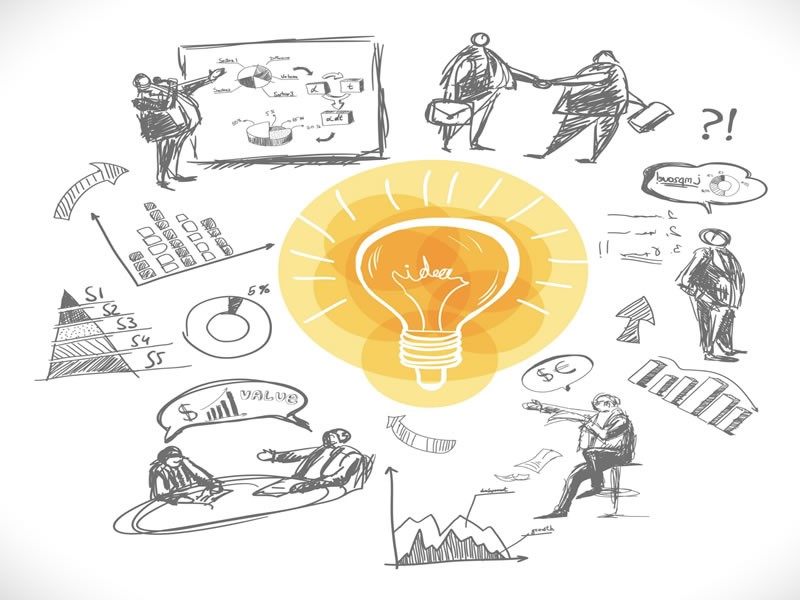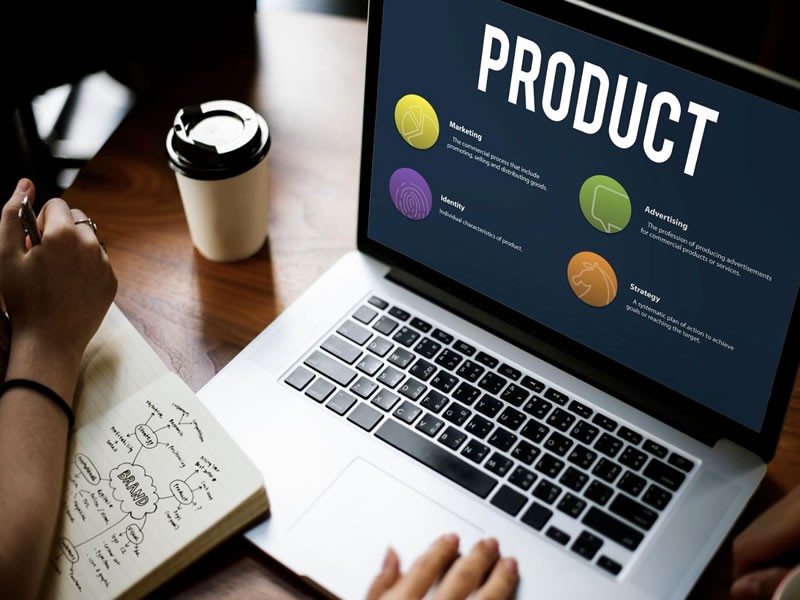Insight Blog
Agility’s perspectives on transforming the employee's experience throughout remote transformation using connected enterprise tools.
14 minutes reading time
(2759 words)
Unlocking the Mechanics of Design Thinking in Product Development
What is Product Development Process? Learn more about Product Development Process and other product management terminology in our resource library.
Design thinking is a versatile methodology rooted in understanding users' needs, challenges and aspirations. Its universal applicability enables professionals from all fields to adopt a user-centric mindset and develop innovative, resonant solutions to complex problems. What makes design thinking particularly effective is its iterative process, which encourages continuous refinement and testing to ensure that the end product truly addresses the user's needs.
The benefits of applying design thinking to product development are manifold. It has the potential to significantly enhance user experience, drive innovation and ensure a robust product-market fit.
By integrating design thinking strategies, companies can navigate the complicated process of developing products that are technologically advanced, emotionally appealing, and highly functional all at once. This approach facilitates a deeper product-user connection and ensures that solutions are meaningful rather than just usable, thereby increasing the likelihood of success in competitive markets.
For businesses requiring assistance with product design NZ is home to a plethora of reputable firms that excel in employing innovative approaches like design thinking.
To work effectively with such valuable partners, it's equally important to understand how design thinking can possibly be implemented in the context of product development.
Let's explore some key tips now:
What is Design Thinking
Design thinking represents a creative problem-solving process rooted in both technical and human-centered disciplines. It employs a multifaceted approach, blending design, engineering, and market research to generate innovative solutions to customer problems.
Design thinking thrives on a perpetual feedback loop, where new insights are gathered, processes and products are tested, and insights are refined and adjusted. This iterative cycle empowers designers to gain a profound understanding of customer needs and refine the product accordingly.
Central to design thinking is the belief that products or services should evolve based on customer needs rather than predetermined notions from the company.
The Design Thinking process is guided by five stages: empathize, define, ideate, prototype, and test. Successful implementation hinges on a deep understanding of the problem and empathizing with users. Collaborative brainstorming sessions play a crucial role in generating diverse ideas and perspectives.
At its essence, design thinking aims to comprehend customer needs, define their problems, and craft creative solutions that effectively address these requirements. It extends beyond the product itself, encompassing the entire customer experience, from research and marketing to customer service. By grasping customer needs, designers can develop products that are not only functional but also intuitive.Design thinking thrives on a perpetual feedback loop, where new insights are gathered, processes and products are tested, and insights are refined and adjusted. This iterative cycle empowers designers to gain a profound understanding of customer needs and refine the product accordingly.
Ultimately, this approach leads to more successful products, as designers can make informed changes based on authentic customer feedback.
As an indispensable tool in product development, design thinking serves to bridge the gap between customer needs and product functionality.
It enables designers to create products that seamlessly align with customer expectations. Through a continuous process of prototyping, testing, and feedback, designers can iteratively enhance the product until it delivers the desired outcome. In essence, design thinking empowers product teams to craft successful, customer-centric products that resonate with their audience.
What is Product Development
Product development is a comprehensive process that involves the creation and enhancement of a product from its conceptualization to its market release. This intricate journey encompasses various stages, each contributing to the overall success of the final product. A well-structured overview of product development is crucial for guiding teams through the intricate steps necessary to bring a concept to fruition.
The initial phase of product development involves ideation and conceptualization. Teams brainstorm ideas, consider market trends, and assess consumer needs to formulate a unique and viable product concept. This stage sets the foundation for subsequent steps, emphasizing the importance of aligning the product with market demands.
Following ideation, the concept moves into the design phase, where detailed plans and specifications are created. This involves translating the conceptualized idea into tangible features and functionalities. Design thinking methodologies are often employed to ensure the product not only meets technical requirements but also resonates with the intended audience on a human level.
Prototyping and testing represent pivotal stages in product development. Prototypes allow for the creation of tangible models, providing a tangible representation of the product's design. Through rigorous testing, teams can identify and rectify potential flaws, ensuring that the final product meets quality standards and performs as intended. This iterative process of refinement is essential to achieving a product that aligns seamlessly with user expectations.
The manufacturing or development phase marks the transition from design to tangible production. Here, all components and features come together to create the final product. Attention to detail and adherence to the design specifications are paramount during this stage to ensure the product's integrity and functionality.
Once the product is manufactured, it undergoes thorough quality assurance checks before entering the market. This stage ensures that each unit meets the established standards for safety, performance, and reliability. Simultaneously, marketing and promotional strategies are developed to create awareness and generate interest in the product.
Post-launch, ongoing product support and updates become critical. Monitoring customer feedback, addressing issues, and implementing improvements contribute to the product's sustained success. An effective overview of product development encompasses these key phases, guiding teams through a structured process that transforms an idea into a successful and sustainable product in the market.
What does Design Thinking and Product Development Encompass
Design thinking and product development represent intertwined processes that form the backbone of innovation in various industries. Design thinking is a human-centric approach to problem-solving that fosters creativity and empathy, emphasizing understanding user needs and iterating solutions. In parallel, product development encompasses the end-to-end journey of transforming an idea into a market-ready product.
Design thinking begins with empathizing and understanding the user's perspective, allowing teams to gain insights into their needs and challenges. Subsequent stages involve defining the problem, ideating creative solutions, prototyping, testing, and implementing iterative improvements. This iterative approach ensures that the final product aligns closely with user expectations and remains adaptable to evolving needs.Product development, on the other hand, encompasses a broader spectrum of activities. It starts with conceptualizing a product idea, progresses through designing detailed specifications, and advances to prototyping and testing. Manufacturing or development follows, culminating in quality assurance and market release.
The process doesn't end there; ongoing post-launch support, feedback incorporation, and product updates are integral for sustained success.
The synergy between design thinking and product development lies in their shared goal: delivering solutions that resonate with users and fulfill market demands. Design thinking injects creativity and user-centricity into each stage of product development, ensuring that the end result not only meets technical requirements but also addresses genuine user needs.
By merging these methodologies, organizations can foster innovation, reduce time-to-market, and enhance product success rates.
The synergy between design thinking and product development lies in their shared goal: delivering solutions that resonate with users and fulfill market demands. Design thinking injects creativity and user-centricity into each stage of product development, ensuring that the end result not only meets technical requirements but also addresses genuine user needs.
By merging these methodologies, organizations can foster innovation, reduce time-to-market, and enhance product success rates.
The dynamic interplay between design thinking principles and the structured phases of product development forms a powerful framework for navigating the complexities of bringing innovative products to market. This collaborative approach harmonizes creativity, empathy, and rigorous development processes, ultimately leading to the creation of products that make a meaningful impact.
Follow us and access great exclusive content everyday: Follow us on Google News
How Does Design Thinking in Product Development Work?
Design thinking offers several advantages that contribute to its widespread adoption and effectiveness in various fields.
Here are key advantages:
- User-Centric Approach: Design thinking places a strong emphasis on understanding and empathizing with end-users. This user-centric approach ensures that the final product aligns closely with the needs, preferences, and experiences of the target audience.
- Creativity and Innovation: Design thinking encourages a creative and iterative problem-solving process. By fostering a mindset of exploration and experimentation, it promotes innovative solutions that may not be apparent through traditional methods.
- Collaboration and Interdisciplinary Teams: The methodology values diverse perspectives and collaboration. Cross-functional teams with members from different disciplines work together, bringing a range of skills and viewpoints to the problem-solving process.
- Flexibility and Adaptability: Design thinking embraces an iterative approach, allowing for flexibility and adaptability. Teams can refine ideas based on continuous feedback, making it easier to respond to changing requirements or unforeseen challenges.
- Efficient Problem Solving: By breaking down complex problems into smaller, manageable parts, design thinking facilitates more efficient problem-solving. This structured approach helps teams focus on specific aspects and address challenges step by step.
- Improved Decision-Making: The emphasis on prototyping and testing ideas allows for quick validation of concepts. This iterative testing process helps in making informed decisions, reducing the risk of investing resources in solutions that may not resonate with users.
- Enhanced Communication: Design thinking promotes effective communication within teams and with stakeholders. Visualization techniques, such as brainstorming sessions and prototyping, make ideas tangible and easily communicable, fostering a shared understanding of concepts.
- Customer Satisfaction: By involving end-users throughout the design process, design thinking contributes to higher customer satisfaction. Products and services developed through this methodology are more likely to meet user expectations and provide a positive experience.
- Risk Mitigation: The iterative nature of design thinking allows teams to identify and address potential risks early in the process. This proactive risk mitigation approach reduces the likelihood of costly errors or product failures.
- Long-Term Success and Market Relevance: Design thinking helps organizations create products and services that are not only functional but also resonate with users. This customer-centric focus contributes to the long-term success and market relevance of the developed solutions.
So the advantages of design thinking lie in its ability to foster innovation, enhance collaboration, and create solutions that genuinely meet user needs. Its holistic and iterative approach has made it a valuable methodology across industries seeking to drive meaningful and customer-centric outcomes
Define the Problem Clearly
The journey of applying design thinking in product development begins with clearly identifying and stating the problem.
This step is crucial as it lays the foundation for all subsequent activities, from ideation to prototyping. A well-defined problem statement guides the team's focus and directs all efforts toward addressing issues that matter most to users. Crafting such a statement involves synthesizing insights from user research to determine what exactly needs to be solved and avoid the common pitfall of making assumptions about user needs.
A good problem statement also goes beyond understanding what the initial issue is all about and appreciates the context in which it exists. It enables teams to differentiate between symptoms and root causes, and this in turn ensures that solutions address the underlying issues rather than just their manifestations.
By framing the problem in a way that captures the perspective of real users, developers can ensure that their solutions are relevant, impactful and genuinely appreciated by the people who will eventually purchase the product.
You may also like: Best Apps for Employees: UPDATED 2022 – A Complete Guide
Empathise with Users
Empathy is the cornerstone of design thinking—it's what helps product developers create solutions that are genuinely aligned with users' needs and experiences.
This step involves engaging with users on a deep level to understand their lives, challenges, and desires. Through techniques such as interviews, observation and empathy mapping, developers gain invaluable insights into the user's world, which will go on to inform every aspect of the development process. These insights help in crafting products that solve practical problems and also resonate emotionally with users.
Empathizing with users requires an open mind and a willingness to question assumptions.
It's about looking beyond the obvious to uncover latent needs that users themselves may not be aware of. For instance, when designing a new healthcare app aimed at improving patient experiences, a team might initially focus on features like appointment scheduling and medical record access.
However, through empathetic engagement with users, they might discover a less obvious need for emotional support during the healthcare journey. This insight could lead them to develop additional app features, such as a community forum or direct messaging with care providers, that address the more emotional aspects of patient care.
Ideate Broadly and Creatively
Once the team has established a clear understanding of the user's needs and a well-defined problem statement, the next phase is ideation.
This stage brings creativity front and center and invites a broad spectrum of ideas that could potentially solve the identified problem. Ideation is characterised by its emphasis on quantity over quality. The underpinning belief is that the best way to arrive at a remarkable solution is to explore as many options as possible. In this phase, all team members are encouraged to contribute regardless of their role or expertise. The result is an environment where diverse perspectives and out-of-the-box thinking are not just welcomed but expected.
Ideation empowers teams to break free from conventional solutions and push the boundaries of what's possible. Techniques such as brainstorming, sketching and mind mapping can facilitate this creative exploration and allow teams to visualise solutions from different angles. It's crucial, however, to engage these activities in a judgment-free environment where every idea is valued.
This openness encourages participation and can give rise to innovative solutions that might not emerge in a more restrictive setting.
Free ebook: How To Get Your Intranet Off The Ground
Prototype Iteratively
Prototyping is an integral part of the design thinking process, as it serves as the bridge between conceptual ideas and tangible solutions. It's about bringing ideas to life, however rudimentary, to explore their potential and test their viability.
Effective prototyping focuses on speed and experimentation rather than perfection. Quick and dirty prototypes enable teams to iterate rapidly, learn from each version, and refine the concept based on real feedback. This approach reduces the risk of costly mistakes later on by identifying flaws and opportunities for improvement early in the development process.
Iterative prototyping is ultimately about thinking through making rather than simply building things on the fly.
Each prototype, whether it's a simple paper model or a more sophisticated digital mockup, offers invaluable insights into how users interact with the product and what aspects resonate most with them. Such turn-on experimentation encourages a deeper understanding of the problem and solution space, allowing developers to pivot as needed and evolve their ideas into more viable products.
Test with Users Early and Often
User testing is where the rubber meets the road in the design thinking process. This phase is critical for validating assumptions, gathering feedback and ensuring that the product resonates with its intended audience.
Early and frequent testing allows teams to catch issues before they become ingrained in the product's design, which can save valuable time and resources in the long run. More importantly, it keeps the product development continually aligned with user needs and expectations.
Testing can take many forms, from one-on-one interviews and usability testing to A/B testing and field studies. The key is to engage real users in realistic scenarios, observe their interactions with the product and listen to their feedback. Direct input from the intended audience is invaluable for identifying pain points and uncovering additional user needs. Teams can then use this insight to further refine the product and enhance its usability and appeal.
At the end of the day, design thinking focuses not just on creating better products but also on fostering a culture of innovation and user-centricity that can drive businesses forward. It offers a powerful framework for developing products that stand out in a crowded marketplace and stay valuable to their users over the long term.
By embracing empathy, creativity, and iterative learning, businesses can navigate the complexities of product development with greater confidence.
Wrapping up
Design Thinking represents a human-centered approach aimed at developing product concepts that effectively address real-world problems. The methodology comprises five distinct stages: empathize, define, ideate, prototype, and test. Application of Design Thinking fosters product improvement, facilitating the creation of innovative, user-friendly solutions that align with the needs and preferences of the target audience.
An increasing number of companies are incorporating Design Thinking techniques, particularly in the release of a minimum viable product (MVP).
To seamlessly integrate Design Thinking into your product development process, it is imperative to clearly define the problem at hand. Subsequently, fostering empathy with users becomes crucial. Encouraging open and collaborative brainstorming sessions further enhances the ideation process. Ultimately, the iterative phases of prototyping and testing contribute to refining the product.
Through a continuous feedback loop and iterative enhancements, Design Thinking proves instrumental in gaining a profound understanding of user needs. This approach ensures the creation of products that not only exhibit functionality and practicality but also evoke desire and delight among users.
Categories
Blog
(2510)
Business Management
(307)
Employee Engagement
(201)
Digital Transformation
(168)
Intranets
(116)
Growth
(110)
Remote Work
(60)
Sales
(47)
Collaboration
(36)
Culture
(29)
Project management
(29)
Customer Experience
(25)
Knowledge Management
(21)
Leadership
(20)
Comparisons
(5)
Ready to learn more? 👍
One platform to optimize, manage and track all of your teams. Your new digital workplace is a click away. 🚀
Free for 14 days, no credit card required.














